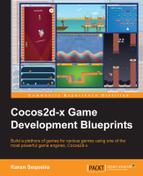Book Description
Build a plethora of games for various genres using one of the most powerful game engines, Cocos2d-x
In Detail
Packed with comprehensive projects, this book takes a detailed look at a few of the industry's most popular games. This book will show you how to use Cocos2d-x to build games using its core components. You will learn how to incorporate game physics, and import custom models and animations. Next, you will see how to include effects such as particles and sounds. With a brief introduction to the upcoming HTML5 platform using Cocos2d-html5, the book goes on to tackle the many different concepts that comprise game development today. You will learn how to build worlds with meshes, a terrain, user interaction, physics, and more. You will start by developing a puzzle game, and then progress on to games that are increasingly complex. Along the way, you'll learn how to build gaming favorites similar to games such as Flappy Bird, Tilt to Live, Jumpy Clown, Angry Birds, and Tower Defense.
What You Will Learn
- Take advantage of the open source nature of Cocos2d-x by extending the engine to customize and add your own features to it
- Design games with level-based and time-based difficulty progression, which are very addictive and keeps users engaged
- Maximize user interaction by implementing intuitive gestures and tilt controls
- Implement advanced physics engine features such as PreSolve and PostSolve events
- Add realism to your game by using a touch event, and use it to control a game
- Implement circle-to-circle collision detection in your games
- Build the same project on multiple platforms, such as Android and Windows, effortlessly
Downloading the example code for this book. You can download the example code files for all Packt books you have purchased from your account at http://www.PacktPub.com. If you purchased this book elsewhere, you can visit http://www.PacktPub.com/support and register to have the files e-mailed directly to you.
Table of Contents
- Cocos2d-x Game Development Blueprints
- Table of Contents
- Cocos2d-x Game Development Blueprints
- Credits
- About the Author
- About the Reviewers
- www.PacktPub.com
- Preface
- 1. A Colorful Start
- An overview of ColourSmash
- Setting up the environment for Cocos2d-html5
- Creating a project in Cocos2d-html5
- Getting acquainted with the project structure
- Creating the first scene – the main menu
- Moving on to the game world
- Summary
- 2. How to Fly a Dragon!
- 3. Not Just a Space Game
- An overview of SpaceCraze
- Creating a project
- Defining the global variables of the game
- Creating your own Sprite
- On to the game world...
- The Player class
- The Enemy class
- The Brick class
- Parsing the level file
- Creating enemies
- Creating bricks
- Creating the player
- Creating HUD elements
- The start and stop functions
- Moving the enemies
- Fire the bullets!
- The update function
- Checking for collisions
- Touch controls
- Level complete and game over
- Summary
- 4. Back to the Drawing Board
- 5. Let's Get Physical!
- An overview of Jumpy Clown
- The basics of Box2D
- Creating the world
- Using debug draw
- Stepping into the world
- Creating the GameObject class
- Creating the walls
- Creating the base
- Creating the clown
- Defining the clown's state machine
- Creating the platform
- Adding and removing platforms
- Adding the controls
- Listening for collisions
- The Collectible class
- Creating and reusing collectibles
- The update loop
- Summary
- 6. Creativity with Textures
- 7. Old is Gold!
- 8. Box2D Meets RUBE
- 9. The Two Towers
- Introduction to Pumpkin Defense
- Defining the properties of the tower
- Defining the properties of the enemy
- Defining the XML file for a level
- Designing the level in Tiled
- The Tower class
- The Lightning class
- The Enemy class
- Spawning waves of enemies
- The GestureLayer class
- Spawning the towers
- Fast forwarding the gameplay
- Summary
- 10. Cross-platform Building
- Index
